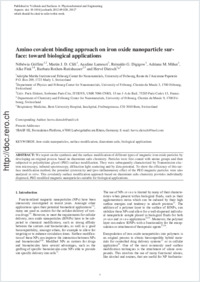Amino covalent binding approach on iron oxide nanoparticle surface: toward biological applications
- Griffete, Nébéwia Adolphe Merkle Institute and Fribourg Center for Nanomaterials, University of Fribourg, Switzerland - Department of Physics and Fribourg Center for Nanomaterials, University of Fribourg, Switzerland
- Clift, Martin J. D. Adolphe Merkle Institute and Fribourg Center for Nanomaterials, University of Fribourg, Switzerland
- Lamouri, Aazdine Univ. Paris Diderot, Sorbonne Paris Cite, ITODYS, Paris, France
- Digigow, Reinaldo G. Adolphe Merkle Institute and Fribourg Center for Nanomaterials, University of Fribourg, Switzerland
- Mihut, Adriana M. Adolphe Merkle Institute and Fribourg Center for Nanomaterials, University of Fribourg, Switzerland
- Petri-Fink, Alke Adolphe Merkle Institute and Fribourg Center for Nanomaterials, University of Fribourg, Switzerland - Department of Chemistry and Fribourg Center for Nanomaterials, University of Fribourg, Switzerland
- Rothen-Rutishauser, Barbara Adolphe Merkle Institute and Fribourg Center for Nanomaterials, University of Fribourg, Switzerland - Respiratory Medicine, Bern University Hospital, Inselspital, Switzerland
- Dietsch, Hervé Adolphe Merkle Institute and Fribourg Center for Nanomaterials, University of Fribourg, Switzerland
-
26.09.2012
Published in:
- Colloids and Surfaces A: Physicochemical and Engineering Aspects. - 2012, vol. 415, p. 98-104
English
We report on the synthesis and the surface modification of different types of magnetic iron oxide particles by developing an original process based on diazonium salts chemistry. Particles were first coated with amino groups and then subjected to polyethylene glycol (PEG) surface modification. They were subsequently characterized by Transmission electron microscopy, infrared spectroscopy, diffraction light scattering and by Zeta potential. To show the efficiency of this surface modification method, the potential cytotoxicity and (pro-)inflammatory effect of the PEG magnetic particles were also analyzed in vitro. This covalently surface modification approach based on diazonium salts chemistry provides individually dispersed, PEG-modified magnetic nanoparticles suitable for biological applications.
- Faculty
- Faculté des sciences et de médecine
- Department
- Département de Chimie
- Language
-
- English
- Classification
- Chemistry
- License
-
License undefined
- Identifiers
-
- RERO DOC 30464
- DOI 10.1016/j.colsurfa.2012.09.020
- Persistent URL
- https://folia.unifr.ch/unifr/documents/302749
Statistics
Document views: 146
File downloads:
- pdf: 317
